Stone- and
Shipsettings:
In general - Ales
stenar
- Anundshög - Arnundstorp - Askeberga - Boge - Ekornavallen - Fröjel - Hasslöv - Hornåsen - Stora
Malm
- List of references
In general:
"Shipsettings"
means a number of raised limestone or errattic blocks, which have been arranged
in the form of a ship. To some of them belongs a so called rune-stone, which
mast-like stands at the middle longitudinal axis. The ground plan is always
sharp oval, which means that bow and stern are of the same kind. While at
the central nave the hight of the stones is lowest, it then again rises towards
the stem and the stern-post (before and behind).
The shipsettings
in Sweden are actually of two different periods. First the ones, that are
from Viking Age or the later part of Iron Age and then the ones from late
Bronze Age only on the island of Gotland. Gotland is a part of Sweden today,
but has for a very long time in prehistory been an area by itself. Only in
Gotland are about 350 of such shipsettings being preserved (for example Gnisvärd,
Gålrum, Rannarve near Klintehamn, Djupvik, Gannarve, Tjelvars grave),
more than anywhere else in the North.
The longest
shipsetting on the island Gotland lies at Gnisvärd / Tofta and is more
than 45 m long, one setting at Stenstu / Levide is 31,5 m and the one at
Gannarve / Fröjel 29 m long.
The ships
lie either alone or in groups. So at the gravefield of Liffride / Lärbro
you can find for example groups of five and at Gålrum / Alskog even
seven shipsettings. The fact that the position of this shipsettings is always
coastal and ashore shows the importance of the waterways.
Mårten
Stenberger writes to this theme: "It is possible, that the custom, to
erect graves in the form of ships, has had symbolical meaning, the same as
many other things in the world of Bronce Age. As a background might have
existed the idea of a vehicle, that should lead the dead one to a land on
the other side of the border of life. But they may also be the expression
for something other, more realistical. The ships may be monuments to remember
proficient sailors and therefore at the same time an expression of the importance
of voyage and trade for the population on the island."
Ales stenar:
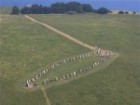 Ales stenar near Kåseberga is considered one
of the cultural monuments of the swedish early history. Erected by the Wikings,
it has a length of 67 m and a width of 19 m, and with that it is the greatest
shipsetting in Scandinavia. It consists of 58 granite blocks, which are partly
over 2 m high and have been arranged in the form of a ship.
Ales stenar near Kåseberga is considered one
of the cultural monuments of the swedish early history. Erected by the Wikings,
it has a length of 67 m and a width of 19 m, and with that it is the greatest
shipsetting in Scandinavia. It consists of 58 granite blocks, which are partly
over 2 m high and have been arranged in the form of a ship.
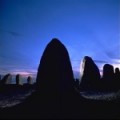 The front block marks exactly the point where the sun
sets at Midsommar and the back block the point of sunrise at winter solstice.
At both sides of the "mainship" were found remains of smaller "escort vessels."
This stonesetting was propably erected either about 500 B.C. (Bronce Age)
or between 500 and 1000 A.D.
The front block marks exactly the point where the sun
sets at Midsommar and the back block the point of sunrise at winter solstice.
At both sides of the "mainship" were found remains of smaller "escort vessels."
This stonesetting was propably erected either about 500 B.C. (Bronce Age)
or between 500 and 1000 A.D.
 Most of such shipsettings
are graves. But this is not shure with ales stenar, since no grave discoveries
were made. The question is if it might have been memorial place for someone
(a great chieftain?), whose bones are not in there, or for example a place
of worship.
Most of such shipsettings
are graves. But this is not shure with ales stenar, since no grave discoveries
were made. The question is if it might have been memorial place for someone
(a great chieftain?), whose bones are not in there, or for example a place
of worship.
Photos
1 & 2 by © Skånes Turistråd; Photo 3 by
© Sveriges
Rese- och Turistråd
Anundshög:
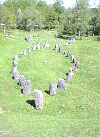 At Anundshög near Västerås
are a total of five shipsettings, the greatest of which is 54 m long. Before
them is to be found a long stonerange, which is in a way a road marking.
Near at hand of this setting stands a rune-stone. It was erected in the first
half of the 11. Century and bears the epigraph: "Folkvid erected all these
stones in honour of his son Heden, Anunds brother. Vred carved the runes."
At Anundshög near Västerås
are a total of five shipsettings, the greatest of which is 54 m long. Before
them is to be found a long stonerange, which is in a way a road marking.
Near at hand of this setting stands a rune-stone. It was erected in the first
half of the 11. Century and bears the epigraph: "Folkvid erected all these
stones in honour of his son Heden, Anunds brother. Vred carved the runes."
Anundshög
itself is about 14 meters high and has a diameter of 60 meters. By that it
is the greatest grave-mound in Sweden. The hills in the surrounding were
probably being erected over fire graves, in which the dead were buried together
with the grave adds.
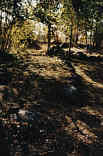 Close to Anundshög exists
an other, smaller grave field with a hill, nine round stone settings and
one shipsetting, which was layed out about between 500 and 1000 A. D. It
is supposed, that women as well as men were being buried under these stone
settings and hills.
Close to Anundshög exists
an other, smaller grave field with a hill, nine round stone settings and
one shipsetting, which was layed out about between 500 and 1000 A. D. It
is supposed, that women as well as men were being buried under these stone
settings and hills.
all
Photos by © Bernhard - I can not help
publishing (with a few matches according to the layout) the original page
here, which my email-friend and "promoter" put into the web specially for
me. Please also visit his homepage, since he deserves it...; Photo 2 by ©
Me
Arnundstorp:
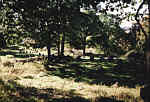 Grave field and limekiln at
Arnundstorp are positioned at the west edge of Billingen, abough the flat
land, which spreads out in the region of Hornborga lake. The limekiln is
from the younger iron age (about 400 - 1050 A. D.) As may be seen very clearly
on the photo on the right bottom, the area on which the stone settings (among
others also one shipsetting) are positioned is being used by one or more
farms of the closer surrounding today.
Grave field and limekiln at
Arnundstorp are positioned at the west edge of Billingen, abough the flat
land, which spreads out in the region of Hornborga lake. The limekiln is
from the younger iron age (about 400 - 1050 A. D.) As may be seen very clearly
on the photo on the right bottom, the area on which the stone settings (among
others also one shipsetting) are positioned is being used by one or more
farms of the closer surrounding today.
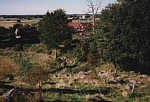 Today only eight visible graves
are left, but it is likely, that originally there had been more. Besides
the grave field are rests of the limekiln, which stood here at the beginning
of the 20th century. Mortar was needed in Sweden since the adoption of stone
construction in the 12th century, and since the middle of the 19th century
the demand of it grew up, when people began to use lime in the paper industry
as well as for the enrichment of earth.
Today only eight visible graves
are left, but it is likely, that originally there had been more. Besides
the grave field are rests of the limekiln, which stood here at the beginning
of the 20th century. Mortar was needed in Sweden since the adoption of stone
construction in the 12th century, and since the middle of the 19th century
the demand of it grew up, when people began to use lime in the paper industry
as well as for the enrichment of earth.
all
Photos by by © Me
Askeberga:

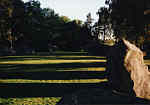 Askeberga near Skövde
is streight after Ale Stenar in Skåne the second largest stonesetting
of Sweden and was erected at the time of the migration of nations, so about
400 A.D. It is also being called "Ranes Stenar." Each of the 24 stone blocks,
Askeberga consists of, is between 25 and 30 tons heavy. As such big stone
blocks are not being found in the near vicinity, they must have been transported
at a long distance. The shipsetting of Askeberga is 55 m long.
Askeberga near Skövde
is streight after Ale Stenar in Skåne the second largest stonesetting
of Sweden and was erected at the time of the migration of nations, so about
400 A.D. It is also being called "Ranes Stenar." Each of the 24 stone blocks,
Askeberga consists of, is between 25 and 30 tons heavy. As such big stone
blocks are not being found in the near vicinity, they must have been transported
at a long distance. The shipsetting of Askeberga is 55 m long.
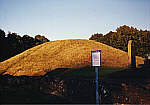 Not far from this place, in Flistad, lies king Ranes
grave from the Iron Age.
Not far from this place, in Flistad, lies king Ranes
grave from the Iron Age.
all
Photos by by © Me
Boge:
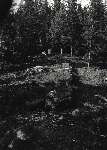 "Tjelder´s Grave" in
the district Södermanland at Katrineholm (before and after the restauration
1938)
"Tjelder´s Grave" in
the district Södermanland at Katrineholm (before and after the restauration
1938)
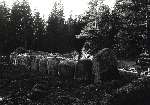
all
Photos by © Antikvarisk-topografiska
arkivet
Ekornavallen:
 Ekornavallen is placed at
the valley of the river Slafsan in a region, which is very rich at relics
of the past. Here graves from all epochs can be found. The first humans were
buried on Ekornavallen around 3000 B. C. After that the place was being used
during at least 4000 years as a grave field. Today sheep graze there.
Ekornavallen is placed at
the valley of the river Slafsan in a region, which is very rich at relics
of the past. Here graves from all epochs can be found. The first humans were
buried on Ekornavallen around 3000 B. C. After that the place was being used
during at least 4000 years as a grave field. Today sheep graze there.
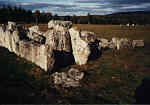 The graves or the first thousand
years of the iron age are missing here, because they were destroyed by farming
etc. Since Ekornavallen has not been examined archaeologically yet, no founds
of for example bones were being made so far.
The graves or the first thousand
years of the iron age are missing here, because they were destroyed by farming
etc. Since Ekornavallen has not been examined archaeologically yet, no founds
of for example bones were being made so far.
Ekornavallen
conceiles graves from the whole prehistory of Sweden: Stone age, bronce age
and iron age. The inhabitants of Hornborga have been using the area as pasture-ground.
With the cultivation during the 90s of the 19th century many of the antiques
have been destroyed.
all
Photos by by © Me
Fröjel:

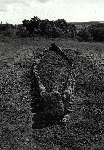 Of the originally two ships of the shipsetting
"Gannarve" on Gotland (Fröjel) is only one left today. This setting,
which is 29 m long and 5 m wide has been erected during the younger Bronce
Age. Besides the big stem stones at the examination in 1959 there were also
found rests of the smaller stones of the middleship, so a restauration became
possible.
Of the originally two ships of the shipsetting
"Gannarve" on Gotland (Fröjel) is only one left today. This setting,
which is 29 m long and 5 m wide has been erected during the younger Bronce
Age. Besides the big stem stones at the examination in 1959 there were also
found rests of the smaller stones of the middleship, so a restauration became
possible.
Photo
1 by © Sveriges Rese-
och Turistråd; Photo 2 by © Antikvarisk-topografiska arkivet
Hasslöv:
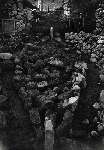 The grave at Lugnaro / Hasslöv consisted originally
out of a mound of 3,75 m height over a mound of stones, which covered the
8 m long shipsetting. The setting is adjusted east-westwards, built of small
stones, which are about 40 cm high and stand very close together, and one
big stem stone at each end. Inside the setting the mortal remains of a female
as well as a male person were found. Because of the fact, that the setting
was being covered by the mound, it was not visible by those still alive,
therefore it may only have been made as a vehicle to send the death ones
to the beyond.
The grave at Lugnaro / Hasslöv consisted originally
out of a mound of 3,75 m height over a mound of stones, which covered the
8 m long shipsetting. The setting is adjusted east-westwards, built of small
stones, which are about 40 cm high and stand very close together, and one
big stem stone at each end. Inside the setting the mortal remains of a female
as well as a male person were found. Because of the fact, that the setting
was being covered by the mound, it was not visible by those still alive,
therefore it may only have been made as a vehicle to send the death ones
to the beyond.
Photo
by © Antikvarisk-topografiska
arkivet
Hornåsen:
 The following epigraph is
to be found on the spot:
The following epigraph is
to be found on the spot:
"Gravfältet
vid Hornåsen, som är ett av Västmanlands största och
märkligaste, består av 200 gravar, de flesta runda stensättningar.
Dessutom finns det en kvadratisk och två skeppsformiga stensättningar,
sju rösen, en hög, (...) och en rest sten. Några gravar undersöktes
på 1920-talet, varvid påträffades fynd, som kan dateras
till volkvandringstid (400 - 550 e. Kr.) Tidsmässigt spänner dock
gravfältet över en betydlig längre period, troligen innefattande
både bronsåldern (1500 - 500 f. Kr.) och större delen av
järnåldern (500 f. Kr. - 1000 e. Kr.) Gravfältet ligger vid
en knutpunkt på den viktiga vägen över Mälaren och visar
att människor bott här under lång tid."
"The
grave field near Hornåsen, which is one of Västmanslands´
biggests and greatests, consists of 200 graves, most of them are round stonesettings.
Besides there are one quadratic and two shipsettings, seven stone stacks,
one hill, (...) and one rune-stone. Some of the graves were examined about
1920, in the course of which were made finds, that may be dated as from the
migration of nations. The span of time of the grave field goes over a much
longer period, propably it contains the Bronce Age (1500 - 500 B.C.) as well
as the major part of the Iron Age (500 B.C. - 1000 A.D.) The grave field
is located at a junction over the Mälarsea and proves, that people lived
here over a long period."
Photos
1 & 2 by © Bernhard;
Stora Malm:
 "Glysa´s Grave" on Gotland (Stora Malm)
"Glysa´s Grave" on Gotland (Stora Malm)
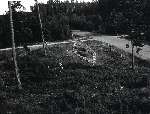
all
Photos by © Antikvarisk-topografiska
arkivet
-
Ulrich Quack: Gotland. Dumont Reiseführer.
Köln 1997
-
Jutta Wertmeyer: Südschweden mit Stockholm.
Köln 1996
-
Jean-Pierre Mohen: Megalithkultur in Europa
- Geheimnis der frühen Zivilisationen. Belser Verlag. Stuttgart
1989
-
Torsten Capelle: Kultur- und Kunstgeschichte
der Wikinger. Wissenschaftliche Buchgesellschaft. Darmstadt 1986
-
Sveriges Rese- och Turistråd, http://www.visit-sweden.com/start.asp
-
Mårten Stenberger: Vorgeschichte
Schwedens. 1977
-
Märta Strömberg: Die bronzezeitlichen
Schiffssetzungen im Norden. Meddelanden från Lunds universitets
historiska museum. 1960
©Angelika
Friedrich, Jan. 2000
http://www.schwedenecke.de/


 Ales stenar near Kåseberga is considered one
of the cultural monuments of the swedish early history. Erected by the Wikings,
it has a length of 67 m and a width of 19 m, and with that it is the greatest
shipsetting in Scandinavia. It consists of 58 granite blocks, which are partly
over 2 m high and have been arranged in the form of a ship.
Ales stenar near Kåseberga is considered one
of the cultural monuments of the swedish early history. Erected by the Wikings,
it has a length of 67 m and a width of 19 m, and with that it is the greatest
shipsetting in Scandinavia. It consists of 58 granite blocks, which are partly
over 2 m high and have been arranged in the form of a ship.

















